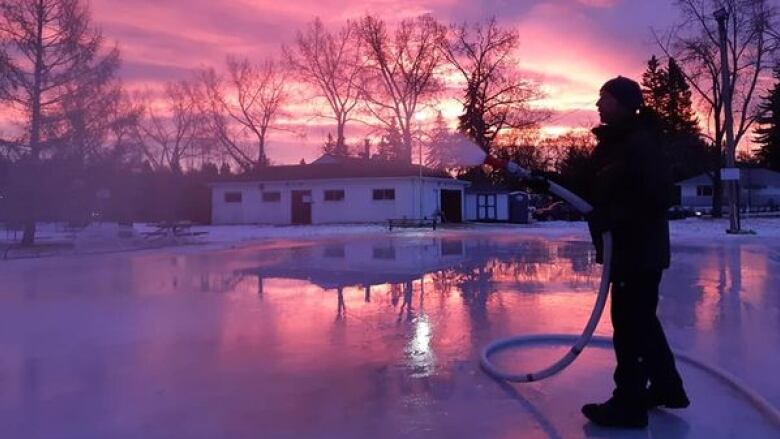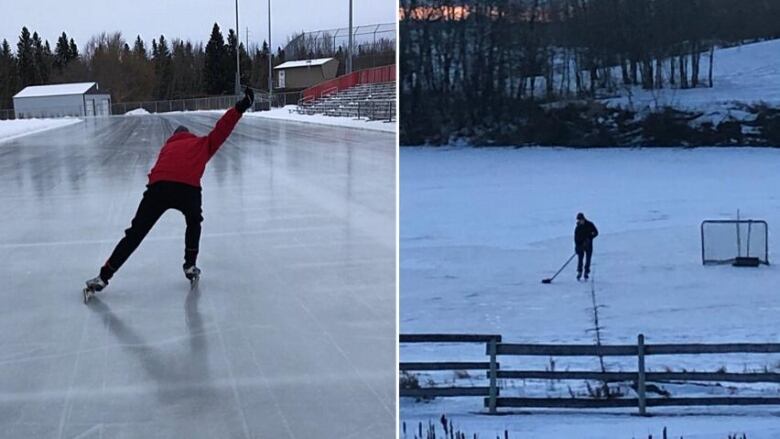Outdoor rink-making tips from an NHL expert
Dan Craig is VP of facilities operations for the league and he has some advice

If there's anyone who knows what goes into making a great ice skating rink, it's Dan Craig.
As vice-president of facilities operations for the National Hockey League, he's made ice indoors and outdoors for the league including for the NHL Winter Classic games over the past 30 years.
Craig, who grew up in Jasper, got his start as an NHL icemaker with the Edmonton Oilers in the 1980s for games at theNorthlands Coliseum, since replaced by the Rogers Place.
These days, he's spending his time tending to his backyard rink at home in River Falls, Wisconsin.
He joined Alberta at Noon host Judy Aldous on Friday to share his rink-building and maintaining expertise for all who love to skate.
Here's his ice building tips for smooth, skateable outdoor rinks worthy of any NHL skater.
Plan ahead
"The biggest part is the planning part and just making sure that you are able to maintain the area," said Craig.
He advises paying attention to the slope of the ground when picking your spot.
"In the spring, it is going to run off and you really would like to have your neighbours really like you.
"You don't want 3,000 gallons of water going into your neighbours'yards or into their basements."
Pick a level, shady spot, so the ice melts slower in the spring, he says.
Oh @AlbertaatNoon! This discussion gets me in the feels.
My extended family meets on the ODR for a Christmas game each year (except this year). From beer league to amateur, from WHL to Novice. pic.twitter.com/n360VKZ4tG
—@Cheryl_ArkisonStart with the right materials
Craig recommends using a tarp for the first layerof the rink, especially if your hometown is proneto temperature fluctuations.
"If it's only going to be 5 degrees Celsius, that's when you really want to get yourself started [with a tarp], because it's going to probably be to mid-January before you can really freeze the ground solid. So having a sheet of plastic, that really gets you going for a good start."
He says you should invest in a bristlybroom to get the edges of the rink clean before you flood the rink.

Bigger is not always better
Craig advises being realistic about the size of your rink, as they can be time-consuming to maintain.
"Ours is 60 feet by 30 feet it's a good size. But at the same time, if I had a regular job, trying to build a sheet of ice andget out there three or four times a night and then go to work at seven o'clock tomorrow, the week would be a little tiring by the time you got done."
Wait for cold enough weather
He says it's best to wait until temperatures dip below freezing for creating your rink and resurfacing it.
"Make sure that before you go out there to do any type of resurfacing, it does get far enough below that freezing mark that you're not going to let water just sit there, and then [form] what they call shell ice. So you want tomake sure you really let Mother Nature do her her work. And if you have to go out there at one o'clock in the morning, that's what you do," said Craig.
@AlbertaatNoon First skate on our #ODR in Fort McMurray was Nov 15th. We typically skate until mid-April.
Dan, age old question... hot or cold water to resurface? And how cold is too cold (outside temp) to resurface? pic.twitter.com/r7HLTkVZbL
—@sirk_25Water temperature matters
He says ideally to get the "best of the best," use hot water for flooding your rink.
"But the thing that I really thought out early in life is that when your wife is having a bath, you probably should not be taking hot water out of your hot water tank to do your ice rink."
He says he won't make that mistake again so opts for cold water.
Wait for the right temperature to resurface the rink
Craig says so long as the new layer is thin, you can resurface at between 15 to 18 C.
"Below that, I think it's a little bit too cold. Then you definitely would have to use hot water if you need to really get it done."
Once the rink is built, he recommends adding only enough water to fill in the skate cuts otherwise, the new layer may flake off.

Get thinner layer with a spray nozzle
"We like to use a fine spray," said Craig.
He warns if you are doing it alone, watch that you don't drag you hose through the water you spray.
"If it's really cold outside, you'll start making slush right away and then all of a sudden you get slush on the backside of your hose," said Craig.
He also warns tomake sureyou don't trip over the hose, lest you get a face full of slush.
With files from Alberta at Noon.












_(720p).jpg)


 OFFICIAL HD MUSIC VIDEO.jpg)
.jpg)



























































































